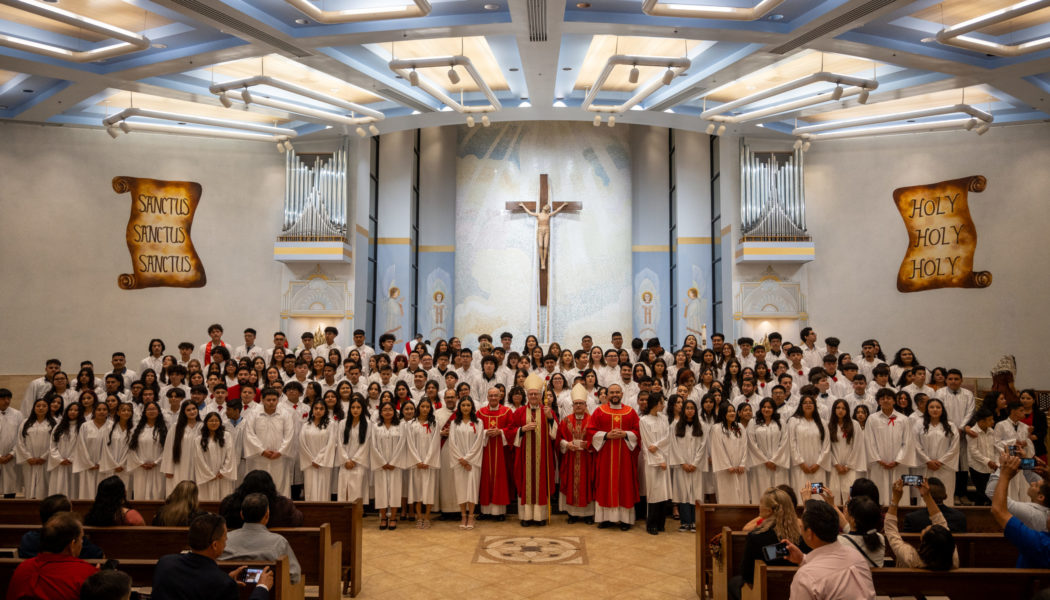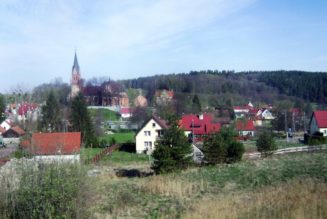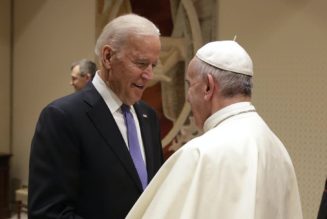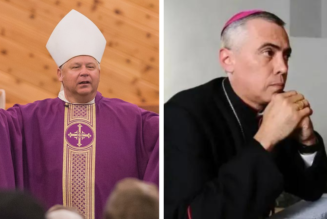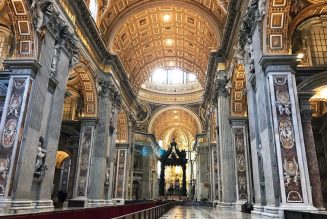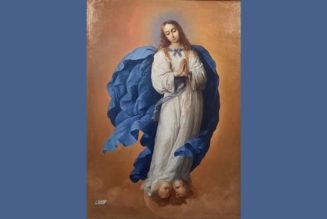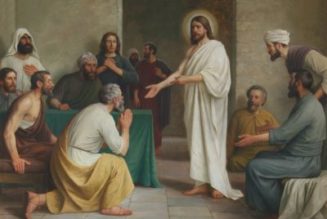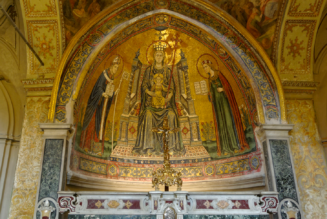Catholics in Las Vegas know what comes to mind when you think of their city: casinos, neon lights, cocktail waitresses, the vice squad, Elvis impersonators, what-happens-in-Vegas-stays-in-Vegas.
And, of course, this weekend, the Super Bowl.
But away from the glitz of the Strip and the media glow of the Big Game on Feb. 11 between the Kansas City Chiefs and the San Francisco 49ers lies a Las Vegas you may never have heard of: a flourishing, emerging Catholic hub that’s growing so quickly the recently designated Archdiocese of Las Vegas can’t build new churches fast enough.
You think the roulette tables are crowded at The Mirage this weekend? Try getting a seat at Sunday Mass.
In the greater Las Vegas area, some parishes routinely have 200 children receiving first Holy Communion each year.
The confirmation classes at some parishes are so big, up to 500 each year, they need a second bishop on hand to keep the lines moving.

One parish — St. Anne’s in the city of Las Vegas — has more than 40,000 parishioners.
It’s not just that the archdiocese is super-sized (the official number is 750,000 people, about double what it was in 1995), it’s also a magnet for young families drawn by the vibrant Catholic spirituality and parish life.
“The perceptions of most people are so different from what’s happening here, it’s amazing,” said Leo Falkensammer, founder of a travel agency with 70 employees and a native of Austria who moved to Las Vegas in 1966.
“What the Strip is doing and what we are doing in our own neighborhoods are two completely different things,” he said.
“Our churches are full on Sunday, and we need more. What would be nice is if you could take some of the churches on the East Coast and bring them to Las Vegas.”
You Sure About This?
Some religious people are hesitant about moving to Las Vegas.
About 20 years ago, Rick Gordon’s brother, a diocesan priest, asked Rick to consider moving his young family from Pittsburgh into a new parish in the Las Vegas Valley that he was founding. But even though Rick had grown up in the area, he wasn’t sure coming back was a good idea.
He visited. What he found surprised him. The parish had no building of its own, but 30 to 40 people crowded into a nearby hospital chapel for daily Mass, including parents with small children. People knelt on the floor of a public-school cafeteria for Sunday Mass and Eucharistic adoration.
“It was seeing young Catholic families living their faith in Sin City,” said Gordon, a lawyer. “That was a big moment for us to say ‘Yes, we should do this. We should come home.’”
In 2018, then-Helena Bishop George Leo Thomas was asked to take over the diocese. He hadn’t been to Vegas in 20 years, and he wasn’t sure what to expect.
“So, when I drove over the horizon from Montana and came down into the valley, I was by myself, and I said, ‘Lord, are you sure this is a good idea?’” he told the Register.
He had a picture of himself taken while standing under the iconic “Welcome to Las Vegas” sign and sent it back to Montana with the caption: “Pope gambles big in Las Vegas.”
But he was surprised by what he found — an energy he hadn’t seen elsewhere. He was also intrigued by the two vastly different types of Church life.
On the Strip, the cathedral and two other churches serve mostly tourists — some of the on-average 750,000-plus visitors who come to Vegas each week for conferences, casinos and resorts. Auxiliary Bishop Gregory Gordon (Rick Gordon’s brother) told the Register that Guardian Angel Cathedral received a special dispensation more than 20 years ago from the Vatican for a 2:30 p.m. Saturday vigil Mass, which accommodates both tourists and people who work evening shifts in hospitality.
Away from the Strip, the local Church is dominated by growing neighborhoods of people who have put down roots and are involved in their local parishes.
Archbishop Thomas describes Catholicism in Vegas as “a cooperative venture” between priests and laypeople.
“I’ve just been really surprised at how life-giving this appointment has been,” said Archbishop Thomas, 73. “And I say it because we’ve got such strong laywomen and laymen in our communities who are serving side by side with our pastors.”
The Catholic boom follows the overall growth of the area.
In July 2023, Redfin, a real estate brokerage company, reported that Las Vegas was at that moment the most popular destination for homebuyers moving elsewhere in the country. Most are fleeing high-tax, high-cost California, particularly Los Angeles and San Francisco, though significant numbers also come from Seattle, San Diego and Chicago.
The median sale price for a home in Las Vegas is less than half the median sale price of a home in Los Angeles, San Francisco, San Jose and San Diego, according to Redfin.
Many people like the dry desert climate. The local economy has done well — not just the famous resort casinos, but also the entertainment venues and conference facilities.
Las Vegas also draws immigrants, many of them from predominantly Catholic countries, such as Mexico, Peru, Colombia, Venezuela, Poland and the Philippines — as well as Vietnam, South Korea, Nigeria, Uganda, Tanzania and India.

As a result, Clark County, which includes the cities of Las Vegas (656,000), Henderson (331,000) and North Las Vegas (280,000), is one of the fastest-growing areas in the United States.
In 1969, Clark County’s population was 267,479, according to one study. In 2022, it was 2,322,985. That’s 768% growth in 53 years. During that same period, the state of Nevada grew 562%. By comparison, during that same period, the population of the United States grew only about 66%.
When Connie Clough moved to the Las Vegas Valley in 1976, if she drove into Nevada from Arizona she would see the lights of the city of Las Vegas only when she got near it.
“Now, you could be 100 miles away and see the lights of Las Vegas, because the city has grown,” said Clough, the Archdiocese of Las Vegas’ director of faith formation.
Out of Nowhere
Until fairly recently, there was no Las Vegas diocese. From 1931 to 1976, Las Vegas was in Church terms just a city near the southern end of the Diocese of Reno, where the cathedral is 350 miles to the northwest. That year, Pope Paul VI recognized the growth of “Sin City” by putting a hyphen in the diocese’s name: the Diocese of Reno-Las Vegas.
In 1995, Pope John Paul II created a second diocese in Nevada, covering the southern half of the state — the Diocese of Las Vegas. Like Reno, it was a suffragan diocese of the Archdiocese of San Francisco, meaning the archbishop of San Francisco had limited oversight over it.
About four years ago, then-Bishop Thomas asked the papal nuncio (Pope Francis’ personal representative in the country) about a possible realignment. San Francisco is more than eight hours from Las Vegas. Los Angeles is only about four. Would it make sense, he wondered, to make Las Vegas a suffragan see of Los Angeles?
The continued rapid growth in Vegas, though, eventually led to another conversation: Should Las Vegas become an archdiocese, with limited oversight over the Diocese of Salt Lake City (which covers the entire state of Utah) and the Diocese of Reno (which gave birth to the Las Vegas diocese 29 years ago)?
Bishops in the region approved the idea. Then the U.S. bishops approved it. Then Pope Francis approved it. On May 23, 2023, now-Archbishop Thomas got a telephone call informing him of the elevation, which was announced publicly May 30 and marked by a Mass of canonical establishment at the Shrine of the Most Holy Redeemer in Las Vegas on Oct. 16.

During his remarks at the end of Mass, Archbishop Thomas called himself “one of the happiest and most grateful bishops in the USA” He ended: “Viva Jesucristo! Viva Papa Francesco! And Viva Las Vegas!”
Growing Pains
Ever sneak into Sunday Mass while the priest is going down the aisle and have plenty of pews to choose from?
You probably don’t live in the Archdiocese of Las Vegas.
Catholics there describe parishes where the church is full for every weekend Mass and it’s hard to find a spot in the parking lot.
Such growth comes with difficulties. Clough, who heads religious education in the archdiocese, said the numbers and diversity of churchgoers make it hard for some parishes to accommodate the various spiritual devotions they bring with them from their cultures.
The archdiocese also needs more priests. Only 36 priests are incardinated in the archdiocese, though Archbishop Thomas said he can rely on more than 90 in total, thanks mostly to the presence of religious orders and retired military chaplains.
Even so, boosting vocations is a high priority. The number of seminarians in the archdiocese has increased from four to 10 since Archbishop Thomas arrived in 2018. Five new applications may bring that figure up to 15, and eight more possible candidates are discerning, he said.
Auxiliary Bishop Gordon, who studied at seminaries in Philadelphia and Rome, said he has classmates in other parts of the country who are dealing with parish closings and mergers. In Las Vegas, it’s the opposite problem. Most original parish churches have been replaced by churches double their size. New churches have been built, and more are needed.
But he said it’s a good problem to have.
“I say prayers of thanksgiving to God that I’ve been blessed to serve as a priest in a diocese that’s experiencing this type of growth — with very little historic infrastructure, but faithful believers, and ministering to them and nurturing them with the sacraments and with the word of God,” Bishop Gordon said.
Raising Catholic Kids in Sin City
How is a place famously known as “Sin City” also the home of fervent, family-oriented Catholic parishes?
For Rick Gordon, 50, who has seven kids ages 11 to 25 and is president of the local chapter of Legatus, the Catholic business leaders’ organization, Las Vegas calls to mind St. Paul’s words in Romans 5:20: “Where sin abounds, grace abounds all the more.”
Gordon and his wife found in their parish, St. Francis of Assisi in Henderson, a strong religious-education program and Catholic moms group. For a while they home-schooled, and through co-ops, they found Catholic home-schooling families serious about their faith. Their kids made friends at the parish, and so did they.
Even the broader culture “assisted in Catholic life,” Gordon said. When a friend visited, he told Gordon he was amazed at how many family-friendly activities there were in the area, including parks, hikes, youth sports and hay rides.
When Gordon’s kids eventually went to public schools, they met a lot of people they could identify with, whether they were Catholics or not.
“There are actually a lot of families that were trying to do a lot of the same things that we were trying to do, which was to raise healthy, balanced, virtuous children,” Gordon said.
Joe Micatrotto, 72, a restaurateur and founder of the Buca di Beppo chain, who moved to the valley in 2001, has lived in various parts of the country. He liked them all — but, he said: “Nothing compares to Las Vegas.”
The religious fervor surprised him.
“I never dreamt I would be in the midst of such a vibrant Catholic community. And it’s not all the same color. It’s not the same ethnicity. All they have in common is they’re raising Roman Catholics,” Micatrotto said.
“I think God smiles a lot when he looks at Las Vegas.”
